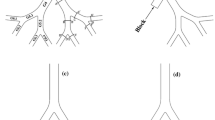Abstract
To investigate airflow pattern and its impact on particle deposition, finite-volume based computational fluid dynamics (CFD) simulations were conducted in the diseased triple-bifurcation airways. Computations were carried out for twenty Reynolds numbers ranging from 100 to 2 000 in the step of 100. Particles in the size range of 1–10 μm were conducted. Two particle deposition mechanisms (gravitational sedimentation and inertial impaction) were considered. The results indicate that there are strong relationship between airflow structures and particle deposition patterns. Deposition efficiency is different for different particles in the whole range of the respiratory rates. Particles in different sizes can deposit at different sites. Smaller particles can be uniformly deposited at the inside wall of the considered model. Larger particles can be mainly deposited in the proximal bifurcations. Deposition fraction varies a lot for different inlet Reynolds numbers. For lower Reynolds numbers, deposition fraction is relatively small and varies a little with varying the diameters. For higher Reynolds numbers, there is a most efficient diameter for each Reynolds number to target the aerosols at the specific site.
Similar content being viewed by others
References
BARNES P J, CELLI B R. Systemic manifestations and comorbidities of COPD [J]. European Respiratory Journal, 2009, 33: 1165–1185.
BARNES P J. Immunology of asthma and chronic obstructive pulmonary disease [J]. Nature Reviews Immunology, 2008, 8: 183–192.
KLEINERT S. COPD-Call for papers [J]. The Lancet, 2009, 373: 108.
JAWOREK A. Micro- and nano-particle production by electrospraying [J]. Powder Technology, 2007, 176(1): 18–35.
WELTE T. Optimising treatment for COPD-New strategies for combination therapy [J]. The International Journal of Clinical Practice, 2009, 63(8): 1136–1149.
CHALUPA D C, MORROW P E, OBERDÖRSTER G, UTELL M J, FRAMPTON M W. Ultrafine particle deposition in subjects with asthma [J]. Environmental Health Perspectives, 2004, 112: 879–882.
YANG X L, LIU Y, SO R M C, YANG J M. The effect of inlet velocity profile on the bifurcation COPD airway flow [J]. Computers in Biology and Medicine, 2006, 36: 181–194.
YANG X L, LIU Y, LUO H Y. Respiratory flow in obstructed airways [J]. Journal of Biomechanics, 2006, 39: 2743–2751.
LUO H Y, LIU Y, YANG X L. Particle deposition in obstructed airways [J]. Journal of Biomechanics, 2007, 40: 3096–3104.
ZHANG Z, KLEINSTREUER C, KIM C S, HICKEY A J. Aerosol transport and deposition in a triple bifurcation bronchial airway model with local tumors [J]. Inhalation Toxicology, 2002, 14: 1111–1133.
KLEINSTREUER C, ZHANG Z. Targeted drug aerosol deposition analysis for a four-generation lung airway model with hemispherical tumors [J]. Journal of Biomechanical Engineering, 2003, 125: 197–206.
KLEINSTREUER C, ZHANG Z. An adjustable triple-bifurcation unit model for air-particle flow simulations in human tracheobronchial airways [J]. Journal of Biomechanical Engineering, 2009, 131(2)
FARKAS Á, BALÁSHÁZY I. Simulation of the effect of local obstructions and blockage on airflow and aerosol deposition in central human airways [J]. Journal of Aerosol Science, 2007, 38: 865–884.
WEIBEL E R. Morphometry of the human lung [M]. New York: Springer, 1963: 140–151.
HEGEDŰS C J, BALÁSHÁZY I, FARKAS Á. Detailed mathematical description of the geometry of airway bifurcations [J]. Respiratory Physiology & Neurobiology, 2004, 141: 99–114.
MICHAELIDES E E. Particles bubbles and drops: Their motion, heat and mass transfer [M]. World Scientific Publishing Co Pte Ltd, 2006: 165–175.
MORSI S A, ALEXANDER A J. An investigation of particle trajectories in two-phase flow systems [J]. Journal of Fluid Mechanism, 1972, 55: 193–208.
COMER J K, KLEINSTREUER C, HYUN S, KIM C S. Aerosol transport and deposition in sequentially bifurcating airways [J]. Journal of Biomechanical Engineering, 2000, 122: 152–158.
KIM C S, FISHER D M. Deposition characteristics of aerosol particles in sequentially bifurcating airway models [J]. Aerosol Science and Technology, 1999, 31: 198–220.
Author information
Authors and Affiliations
Corresponding author
Additional information
Foundation item: Project(51178466) supported by the National Natural Science Foundation of China; Project(200545) supported by the Foundation for the Author of National Excellent Doctoral Dissertation of China; Project(2011JQ006) supported by the Fundamental Research Funds of the Central Universities of China
Rights and permissions
About this article
Cite this article
Ou, Cy., Deng, Qh. & Liu, Ww. Numerical simulation of particle deposition in obstructive human airways. J. Cent. South Univ. Technol. 19, 609–614 (2012). https://doi.org/10.1007/s11771-012-1046-x
Received:
Accepted:
Published:
Issue Date:
DOI: https://doi.org/10.1007/s11771-012-1046-x




